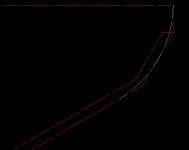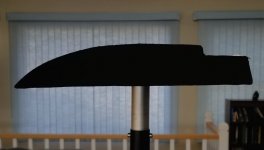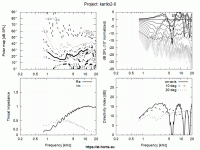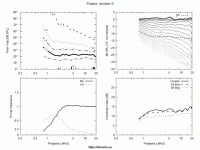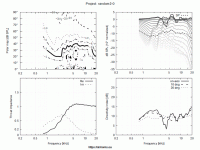I am looking at converting the straight secondary flare of my MEH to a curved profile. (To lose sharp edges / improve mouth termination)
Is it 'good enough' just to round it over, or should it follow some sort of defined curve shape ? (tractrix etc ? )
Attached a side on view of straight vs single radius curve.
Thanks,
Rob.
Is it 'good enough' just to round it over, or should it follow some sort of defined curve shape ? (tractrix etc ? )
Attached a side on view of straight vs single radius curve.
Thanks,
Rob.
Attachments
Hi Rob, i tried this on my syn7 version, a 90x60, about 48" wide.
Here's an end shot of a detachable secondary flare, that fits onto the height side of the primary horn.
I would have made the curvature begin further towards where it connects to the primary, but it is made from 3" thick foamboard and that is all the curvature that could fit into that thickness and still have any relation to a tractix curve.
A member named Oohms has done similar, if you can find it.
It didn't smooth response so much over straight sided secondary flares, and cutting the foamboard curves the full width of the horn was one of the hardest things I've tried to do build wise...(never again haha) .
I'll do the bendy board route i think you're planning, if you or anybody else can demonstrate a good improvement with curved.
Here's an end shot of a detachable secondary flare, that fits onto the height side of the primary horn.
I would have made the curvature begin further towards where it connects to the primary, but it is made from 3" thick foamboard and that is all the curvature that could fit into that thickness and still have any relation to a tractix curve.
A member named Oohms has done similar, if you can find it.
It didn't smooth response so much over straight sided secondary flares, and cutting the foamboard curves the full width of the horn was one of the hardest things I've tried to do build wise...(never again haha) .
I'll do the bendy board route i think you're planning, if you or anybody else can demonstrate a good improvement with curved.
Attachments
Hi Mark,
Thanks for the heads up on Oohms I'll have a search.
I'm thinking of building it in layers of ply (sort of translam style) then using glass fibre / filler to finish the surface.
Cheers,
Rob.
Thanks for the heads up on Oohms I'll have a search.
I'm thinking of building it in layers of ply (sort of translam style) then using glass fibre / filler to finish the surface.
Cheers,
Rob.
If you want a controlled handoff, the LeCleach profile does well. The idea has been explored in this thread - Acoustic Horn Design – The Easy Way (Ath4)
Yeah I'm investigating this very thing with ATH4 but haven't got any conclusions yet. From the tests I've done it looks like the roundover should do no less than ~180 degrees and it looks like the roundover size (radius) depends on other characteristics of the waveguide (depth, opening angle). Just got some decent looking graphs with ATH after maybe 50 runs and next objective is to try to extract some hints for MEH project, for example can a roundover do harm or is it always good and basic things like that 🙂
You don't have to do it in Ath, hornresp is useful too.
There is a continuum of behaviour that you can find when it comes to roundovers. The first point you might want to know is that if you don't use one, the wavefront may see sudden expansion, and a reflection occurs. You might be familiar with improperly terminated antennae and reflections?
There is a continuum of behaviour that you can find when it comes to roundovers. The first point you might want to know is that if you don't use one, the wavefront may see sudden expansion, and a reflection occurs. You might be familiar with improperly terminated antennae and reflections?
I made a conical and few other waveguides with some random profile in ATH and adjusted the roundover only to see if the response gets always better.
These are axisymmetric freestanding simulations. I tried to simulate some straight walled horns but after the long wait there were some errors in the ABEC spectra calculation and couldn't get results out so that was a bummer.
To me, it seems like the roundovers at mouth will never get you worse looking graphs, only better. Other properties of the waveguide will determine the overall response features while the roundover prevents diffraction and mouth reflections ruining the response 🙂 In addition the waveguide gets shallower.
Attached GIF animations have rollback to 180 degrees since that seems to be the sweetspot on a freestanding waveguide. Each GIF show results with no rollback, rollback with Rollback.StartAt = 0.5 and Rollback.StartAt = 0.2. One image is to illustrate the model on the first GIF (named kartio2).
I'd say do a 180 degree rollback, the bigger radius the better 🙂
ps. I just noticed the middle one has pretty good parameters, quite constant directivity!😀
These are axisymmetric freestanding simulations. I tried to simulate some straight walled horns but after the long wait there were some errors in the ABEC spectra calculation and couldn't get results out so that was a bummer.
To me, it seems like the roundovers at mouth will never get you worse looking graphs, only better. Other properties of the waveguide will determine the overall response features while the roundover prevents diffraction and mouth reflections ruining the response 🙂 In addition the waveguide gets shallower.
Attached GIF animations have rollback to 180 degrees since that seems to be the sweetspot on a freestanding waveguide. Each GIF show results with no rollback, rollback with Rollback.StartAt = 0.5 and Rollback.StartAt = 0.2. One image is to illustrate the model on the first GIF (named kartio2).
I'd say do a 180 degree rollback, the bigger radius the better 🙂
ps. I just noticed the middle one has pretty good parameters, quite constant directivity!😀
Attachments
Last edited:
Another quick test, the same waveguide as in last post (kartio2) Rollback.StartAt = 0.5 but the degrees is varied. Shows that about after 90degrees of rollback it is diminishing returns.
So, do a rollback of more than 90 degrees with as big radius as possible to get measurably better results than with the current secondary flare 🙂
So, do a rollback of more than 90 degrees with as big radius as possible to get measurably better results than with the current secondary flare 🙂
Attachments
Last edited:
Hope it helps! It is difficult to find out what is the best rollback/secondary flare since optimizing requires the whole waveguide pretty well modeled and simulated and I couldn't get the ATH script do the heavy lifting.
I feel positive these results are indicative how to get "better" rollback/secondary flare and the rest is about figuring out how to build such thing on a square mouth 😀
I feel positive these results are indicative how to get "better" rollback/secondary flare and the rest is about figuring out how to build such thing on a square mouth 😀
Last edited:
The rollback (ala LeCleach) and the secondary flare are going to get a different kind of result. Baffled is in there too as a common variant.
Out of my skills to simulate enclosure with the waveguide. Infinite baffle is easy with ATH but that doesn't reflect reality either but I'll try it if it shows sometging that could be usefull.
There would be two effects that might be desired and depending on which of those you want to achieve or in what combination would set the choice. A tractrix profile can be very good at low frequency loading. The Klipsh K402 has a bit of a Tractrix like shape to it so it can load lower. The other reason is diffraction control and avoiding reflections from poor mouth termination as Allen said.
If you can't control the flare from the throat all the way to the mouth completely due to construction difficulty then you have already accepted it won't be as good as it can be. Adding a 36mm to 50mm roundover on the edge of the second flare would help to make it terminate better. Even with a good mouth termination to the baffle a roundover or rollback still makes it better from a diffraction and reflection point of view.
I could simulate it but it is a lot of effort in a CAD program to prove something that I know most of the answer to from other simulations already done.
If you can't control the flare from the throat all the way to the mouth completely due to construction difficulty then you have already accepted it won't be as good as it can be. Adding a 36mm to 50mm roundover on the edge of the second flare would help to make it terminate better. Even with a good mouth termination to the baffle a roundover or rollback still makes it better from a diffraction and reflection point of view.
I could simulate it but it is a lot of effort in a CAD program to prove something that I know most of the answer to from other simulations already done.
I'm not sure about some of this. I'd say the throat region is more critical with regards to loading, not that that becomes a high priority in a waveguided system, and the throat region would be the priority in the case that accuracy was difficult to achieve due to construction methods.
Maybe I wasn't clear, if you are going to use a conical horn then making the secondary flare tractrix probably won't make much difference vs just making it at a flat angle and rounding it over. If you could control it all the way to the throat then it might be worth considering more closely.
Mark has built something like the first scenario so data exists already.
When I think about it the CAD effort required to model a straight conical with secondary flare vs one with an added roundover it isn't that great so I might get to it.
Mark has built something like the first scenario so data exists already.
When I think about it the CAD effort required to model a straight conical with secondary flare vs one with an added roundover it isn't that great so I might get to it.
Greetings all,
this is actually a topic of my current interest. Like Rob, I, too, already have a device - a pure OS, and I am setting Ath to investigate.
Re:
I am not quite following. If we are to believe the simulations, it appears that there is significant influence of the interface between the (conical) compression driver exit and (even matching) throat angle of the horn/wave-guide. Although the interface appears to be "smooth" there is significant first derivative difference.
Now taking the argument further, why would the discontinuity at the abrupt change of flare, and consequent first derivative, further from the throat be different? Should a tangential interface not be better?
Now, I am aware that mark100 claims that the trctirx end flare "didn't smooth response so much over straight sided secondary flares", and I have no reason to doubt him. However, it seems to me that we are contemplating something that may have a second of higher order of influence, both regarding measured effect and perceived one. After all, does anyone ever reported perceived difference between Danley's Unity with abrupt change between the first and second flare and a gradual one?
Kindest regards,
M
this is actually a topic of my current interest. Like Rob, I, too, already have a device - a pure OS, and I am setting Ath to investigate.
Re:
Maybe I wasn't clear, if you are going to use a conical horn then making the secondary flare tractrix probably won't make much difference vs just making it at a flat angle and rounding it over. If you could control it all the way to the throat then it might be worth considering more closely.
I am not quite following. If we are to believe the simulations, it appears that there is significant influence of the interface between the (conical) compression driver exit and (even matching) throat angle of the horn/wave-guide. Although the interface appears to be "smooth" there is significant first derivative difference.
Now taking the argument further, why would the discontinuity at the abrupt change of flare, and consequent first derivative, further from the throat be different? Should a tangential interface not be better?
Now, I am aware that mark100 claims that the trctirx end flare "didn't smooth response so much over straight sided secondary flares", and I have no reason to doubt him. However, it seems to me that we are contemplating something that may have a second of higher order of influence, both regarding measured effect and perceived one. After all, does anyone ever reported perceived difference between Danley's Unity with abrupt change between the first and second flare and a gradual one?
Kindest regards,
M
Could you post a link please?Mark has built something like the first scenario so data exists already.
- Home
- Loudspeakers
- Multi-Way
- Should there be a certain type of curve ? MEH Q ?
